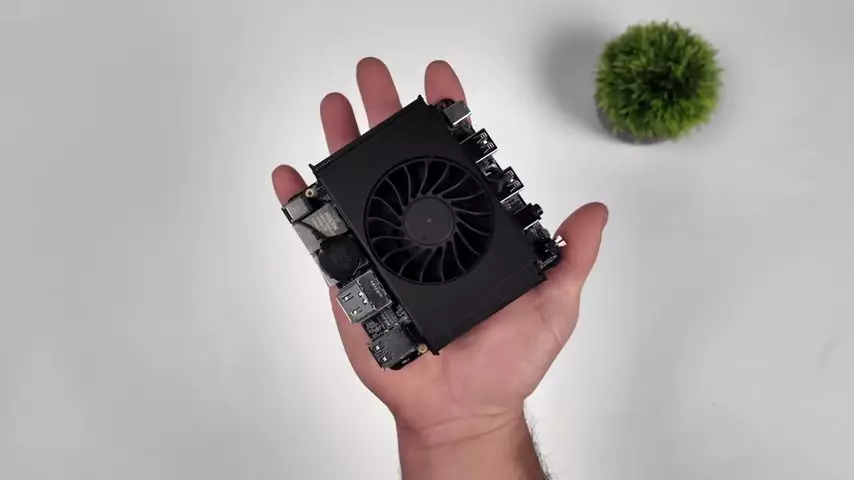As technology continues to evolve at an unprecedented pace, the demand for smaller, yet more powerful computing devices becomes ever more pronounced. The latest developments in single-board computers (SBCs) exemplify this trend, showcasing how high-performance components can be meticulously packed into remarkably compact enclosures. A recent, yet-to-be-announced model exemplifies this miniaturization, boasting a Ryzen 7 7840HS APU along with an RDNA3 architecture. This innovation raises important questions about the future of gaming and computing within limited space constraints.
Traditionally, the belief in requiring a dedicated graphics card for optimal gaming performance has been steadfast. However, advancements in integrated graphics technology are changing the narrative. The new SBC is so diminutive that it could be mistaken for a small GPU. Despite its size, the performance metrics indicate that it can handle contemporary gaming settings remarkably well, outperforming prior expectations for compact devices.
The Ryzen 7 7840HS, a part of AMD’s Phoenix Point series, brings with it an enticing fusion of performance and efficiency. Paired with a Radeon 780M iGPU, it showcases an impressive ability to run demanding titles such as “Doom Eternal” and “Overwatch 2” at impressive frame rates. If you’ve ever thought high-quality gaming experiences were reserved for larger setups, this new model could well change your mind.
When reviewing the performance of this new SBC, it becomes apparent that it can hold its own in a competitive gaming arena. For instance, operating “Doom Eternal” at 1080p with medium settings resulted in an average frame rate of 79 fps. Likewise, “Overwatch 2” showed an output hovering between 80-100 fps, proving this little powerhouse is indeed capable of competitive gaming without needing a supplementary GPU.
Admittedly, larger games such as “God of War” and “Spider-Man Remastered” required frame generation to maintain consistent performance, but that should not overshadow the impressive competency this compact device displayed. What stands out is the realization that not only is the hardware strong enough to play these high-octane games, but it also manages to do so while remaining pocket-sized.
While such innovative technology is exciting, it’s crucial to recognize there are trade-offs. The SBC features soldered LPDDR5 RAM, available in 16 GB and 32 GB options, which limits flexibility concerning upgrades or replacements. Additionally, although the APU is powerful, it does not utilize the latest Strix Point chips—potentially a cost-saving measure that may affect future performance enhancements.
Moreover, the SBC prioritizes size over casing, leading to concerns about durability and practicality. Without a shell, dust and debris can easily compromise the device. Consumers must weigh the benefits of portability against the potential risks of portability-related wear and tear.
One of the standout features is its impressive storage ability, offering three M.2 slots. In comparison, many standard micro-ATX motherboards often feature only one slot. This presents a unique opportunity for users seeking to expand their storage capabilities with ease and efficiency. The prospect of having multiple high-speed SSDs integrated into such a compact system is nothing short of revolutionary.
This allows users not just to store more data but also manage game installations and software applications comfortably. As the push for more extensive and graphically demanding games continues, having extra capacity could prove advantageous for many players.
With a tentative price of $329, and plans for an initial release through Indiegogo, this innovation falls below the cost of many high-end GPUs alone, like the RTX 4060 Ti. This pricing strategy positions the SBC as an appealing option for gamers on a budget who desire a competent gaming experience without the financial strain of a full-fledged gaming rig.
Regardless of its initial price, the expectation is that once in full production, the cost may adapt to market demands and supply constraints. For now, it represents an exciting entry point into accessible gaming hardware for enthusiasts and casual gamers alike.
The introduction of this innovative SBC not only showcases the capabilities that modern hardware can achieve but also opens doors to new possibilities for gaming enthusiasts. Balancing compact design with powerful performance signifies a transformative period in gaming technology, challenging traditional assumptions about what a gaming rig should look like. The era of miniature gaming systems has arrived, and it promises to make waves in both the gaming and computing landscapes.


Leave a Reply